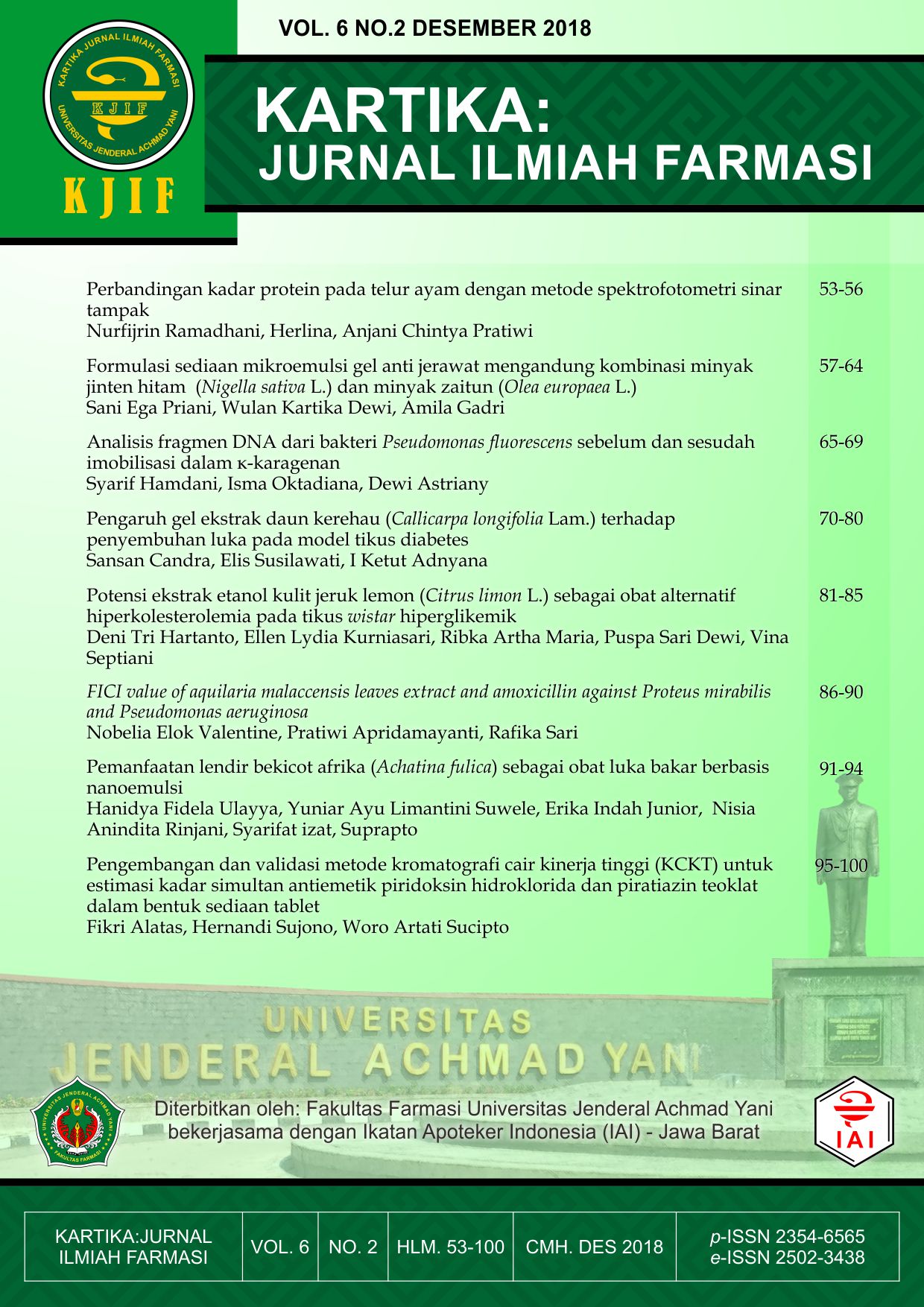FICI VALUE OF AQUILARIA MALACCENSIS LEAVES EXTRACT AND AMOXICILLIN AGAINST PROTEUS MIRABILIS AND PSEUDOMONAS AERUGINOSA
DOI:
https://doi.org/10.26874/kjif.v6i2.157Abstrak
Abstract
Â
Infection is a common disease caused by microbes. The use of antimicrobial drugs such as Amoxicillin is most widely used in Indonesia, but has develop resistance. The resistance of Amoxicillin can be overcome by combining it with Karas leaves (Aquilaria malaccensis Lam.) which has an antibacterial activity. This research was conducted to know the value of Fractional Inhibitory Concentration Index (FICI) from the combination of ethanolic Karas leaves extract (A.malaccensis Lam.) with amoxicillin in Gram-negative bacteria test, that is, Proteus mirabilis and Pseudomonas aeruginosa. This research was used disc diffusion method by Kirby Bauer. Minimum Inhibitory Concentration (MIC) result of ethanolic karas leaves extract (A.malaccensis Lam.) in P.mirabilis and P.aeruginosa was 0.5mg/ml. MIC’s result of amoxicillin in P. mirabilis and P.aeruginosa sequentially were 0.0039 and 0.0625 mg/ml. Then, evaluation of MIC value from combination of ethanolic karas leaves extract and amoxicillin (1/4 x MIC, 1/2 x MIC, 1 x MIC, 2 x MIC and 4 x MIC) showed that the combination of ethanolic karas leaves extract with amoxicillin has characteristics of FICI value on each bacteria, P. aeruginosa: 0.5 (synergistic) and P.mirabilis: 8 (antagonist)Â
Keyword: antibacteria, Aquilaria malaccensis, amoxicillin, FICI
Referensi
Aiyegoro, O. a, & Okoh, a I. (2009). Use of bioactive plant products in combination with standard antibiotics : Implications in antimicrobial chemotherapy.
Amin, M. U., Khurram, M., Khattak, B., & Khan, J. (2015). Antibiotic additive and synergistic action of rutin, morin and quercetin against methicillin resistant Staphylococcus aureus. https://doi.org/10.1186/s12906-015-0580-0
Campbell, N.A., Reece, J.B., Mitchell, L. (2003). Biologi. Edisi kelima, Jilid2. Jakarta: Erlangga.
Cita, Y. P. (2011). Bakteri Salmonella typhi dan demam tifoid. https://doi.org/10.24893/JKMA.6.1.42-46.2011
CLSI. (2015). M100-S25: Performance Standards for Antimicrobial Susceptibility Testing; Twenty-Fifth Informational Supplement.
Dipiro, J.T., Talbert, R.L., Yee, G.C., Matzke, G.R., Wells, B.G., Posey, L. M. (2008). Pharmacotheraphy: A Pathophysiologic Approach. 7th ed. New York: Mc-Graw Hill.
Ebringer, A., Rashid, T. (2009). Rheumatoid Arthritis is caused by Proteus: the Molecular Mimicry Theory and Karl Popper. Frontiers in Bioscience, 1, 577–586.
Huda, A., Munira, M., Fitrya, S.D., Salmah, M. (2009). Antioxidant Activity of Aquilaria malaccensis (Thymelaeaceae) Leaves. Pharmacognocy Research, 1, 270–273.
Integrated Taxonomic Information System. (2011). Aquilaria. Retrieved July 26, 2017, from https://www.itis.gov/servlet/SingleRpt/SingleRpt?search_topic=TSN&search_value=845890#null
Kee, J.L., Hayes, E. R. (1996). Farmakologi pendekatan Proses Keperawatan. Jakarta: Buku Kedokteran EGC.
Kesehatan, K. (2011). Peraturan Menteri Kesehatan Republik Indonesia Nomor 2406/MenKes/Per/XII/2011 Tentang Pedoman Umum Penggunaan Antibiotik. Jakarta: Menteri Kesehatan Republik Indonesia.
Microbewiki. (2016). Escherichia coli. Retrieved September 15, 2017, from https://microbewiki.kenyon.edu/index.php/Escherichia_coli
Mitsuyama, J., Hiruma, R., Yamaguchi, A., & Sawai, T. (1987). Identification of porins in outer membrane of Proteus, Morganella, and Providencia spp. and their role in outer membrane permeation of β-lactams. https://doi.org/10.1128/AAC.31.3.379
Ofokansi, K. C., Attama, A. A., Uzor, P. F., & Ovri, M. O. (2013). Evaluation of the combined antimicrobial activity of the leaf extract of phyllantus muellerianus with ciprofloxacin. https://doi.org/10.7243/2050-120X-2-16
Porco F.V., V. E. B. (1995). Pseudomonas aeruginosa as a cause of infection diarrhea successfully treated with oral ciprofloxacin. The Annals of Phamacotherapy, 29, 1122–1123.
Pradipta, I., Kartikawati, A., Hartanto, H., Febrina, E., Ronasih, E., Abdulah, R., & Amelia, R. (2015). Three years of antibacterial consumption in Indonesian Community Health Centers: The application of anatomical therapeutic chemical/defined daily doses and drug utilization 90% method to monitor antibacterial use. https://doi.org/10.4103/2230-8229.155385
Robiyanto., Sari, R. (2017). Comparison of Antibacterial Activity of Ethanolic Extract of Aquilaria microcarpa Baill. and Aquilaria malaccencis Lamk. Leaves. AJPCR.
Saptarini, N. M. (2012). Evaluation of Content and Dissolution Profile of Generic Amoxicillin Tablets.
Sari, R., Muhani, M., & Fajriaty, I. (2017). Uji Aktivitas Antibakteri Ekstrak Etanol Daun Gaharu ( Aquilaria microcarpa Baill .) Terhadap Bakteri Staphylococcus aureus dan Proteus mirabilis.
Stermitz, F., Lorenz, P., Taawara, J. N., Zenewicz, L. A., Lewis, K. (2000). Synergism in a medicinal plant: Antimicrobial action of berberine potentiated by S-methoxyhydrocarpin-a multidrug pump inhibitor. Proceedings of National Academy of Sciences, 97(4), 1433–1437.
##submission.downloads##
Diterbitkan
Cara Mengutip
Terbitan
Bagian
Lisensi
Penulis yang menerbitkan artikel pada jurnal ini menyetujui ketentuan berikut:
- Penulis memberikan hak cipta dan jaminan atas artikel sebagai publikasi pertama, yang memberikan kesempatan pada orang lain untuk membagi artikel dibawah lisensi Creative Commons Attribution License
- Penulis dapat melakukan perubahan dan menambahkan untuk pendistribusian artikel yang terpublikasi secara non eksklusif (misalnya, mempostingnya ke repositori institusional atau mempublikasikannya dalam sebuah buku), dengan pengakuan publikasi awal dalam jurnal ini.
- Penulis diizinkan dan didorong untuk memposting pekerjaan mereka secara online (misalnya, di repositori institusional atau di situs web mereka) sebelum dan selama proses pengajuan, karena dapat mengarah pada pertukaran produktif, serta kutipan pekerjaan sebelumnya dan lebih besar yang diterbitkan (Lihat The Effect of Open Access).























